Written by Susanna Rosen
![Susanna Rosen_72[1] Susanna Rosen_72[1]](https://gardeninggonewild.com/wp-content/uploads/2011/02/SusannaRosen_721_thumb1.jpg) I had the pleasure of meeting Susanna last April on the International Bulb Centre’s journalists trip to Holland. When I learned about her background and the work she’s presently doing, I thought that she would be a perfect match for Gardening Gone Wild. And how right I was! Susanna is a prolific author, an excellent photographer and on top of that, a kind, gentle and unassuming person. We’re lucky to have her as a Guest Contributor.
I had the pleasure of meeting Susanna last April on the International Bulb Centre’s journalists trip to Holland. When I learned about her background and the work she’s presently doing, I thought that she would be a perfect match for Gardening Gone Wild. And how right I was! Susanna is a prolific author, an excellent photographer and on top of that, a kind, gentle and unassuming person. We’re lucky to have her as a Guest Contributor.
A brief bio on Susanna: She is a Swedish biologist, journalist, writer and photographer. Before Susanna became a freelancer, she held a position at the Swedish Museum of Natural History. She is a zoologist who once did her doctoral research on Australian frogs but her interests eventually turned towards botany. Today she is the author of 13 books on gardening and house plants and two books on cats. She specializes in natural gardening, working according to nature, not against it. Learn more about Susanna and see more of her photos on her website. Fran Sorin
Swedish Lapland is a place of contrast with vivid colours and vast areas of wilderness. In summer you have the midnight sun with sunshine 24 hours a day, and in winter the northern lights. Most people believe that gardening at the Arctic Circle is more than a challenge, that it’s impossible. The fact is that many perennials grow higher and get brighter colours than in the South, and you don’t have the same problems with pests.
Of course you can’t grow every plant you see in garden magazines. But why copy when you can make something different? If you make some adjustment when it comes to the soil and the choice of plants, you can create the most beautiful gardens at this latitude. There is always a “look alike” for every cultivated plant, so you can still create that same general feeling but not with the same plants.
Most of Europe is densely populated with shrinking areas of wild nature but Lapland still has extensive areas of wild forests. While many gardens in England and Holland create woodlands and prairie like borders, the gardens in Lapland do the opposite. They are more controlled to point out the contrast between the garden and the deep forest. The gardens are open with no fences or hedges. The well trimmed lawn clearly points out where the garden begins and nature starts. I believe it’s a way to control nature, to keep it at a distance, rather than bringing it in to your back yard.
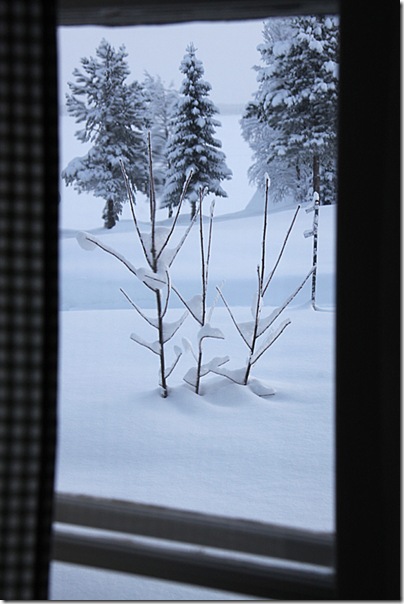 A dormant large flowering bird cherry (Prunus padus ‘Laila’) outside my kitchen window in February. When you choose hardy trees and bushes the its place of origin is important. A tree from Northern Sweden starts preparing itself for the winter earlier than the same species from the South. If you choose a tree of a Southern provenance, it will still have green leaves when the first snow falls in Autumn.
A dormant large flowering bird cherry (Prunus padus ‘Laila’) outside my kitchen window in February. When you choose hardy trees and bushes the its place of origin is important. A tree from Northern Sweden starts preparing itself for the winter earlier than the same species from the South. If you choose a tree of a Southern provenance, it will still have green leaves when the first snow falls in Autumn.
![Lapland_2[1] Lapland_2[1]](https://gardeninggonewild.com/wp-content/uploads/2011/02/Lapland_21_thumb.jpg) Gardens in Lapland are a good example of “maximalism” instead of mimimalism, with a mixture of different plants in strong colours, both perennials and annuals. Most perennials grow much higher and the colors of the flowers are brighter than in the South and you don’t have the problem with pests damaging the foliage. In the background (above photo) you can see an enormous well trimmed lawn, mowed twice a week, as a contrast to the extensive forests in the background. This garden is in the mountain region 60 km West of Jokkmokk.
Gardens in Lapland are a good example of “maximalism” instead of mimimalism, with a mixture of different plants in strong colours, both perennials and annuals. Most perennials grow much higher and the colors of the flowers are brighter than in the South and you don’t have the problem with pests damaging the foliage. In the background (above photo) you can see an enormous well trimmed lawn, mowed twice a week, as a contrast to the extensive forests in the background. This garden is in the mountain region 60 km West of Jokkmokk.
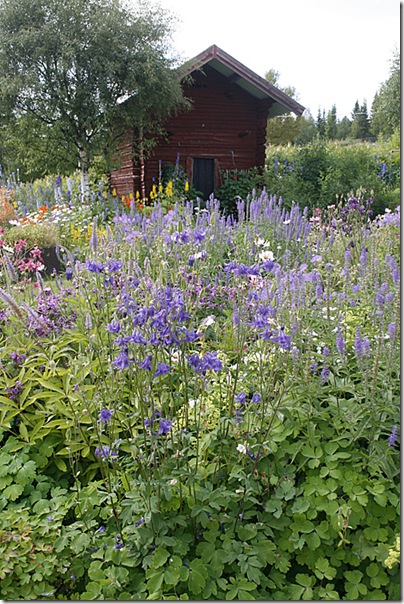 The temperature range is often more than 60 degrees, from more than -30 degrees C in winter and sometimes +30 degrees during warm summer days. As long as the plants are covered by snow in winter they survive. It’s not the cold that is the problem, it’s rather the soil. It you have well drained soil, you can grow most herbaceous plants. This is from a garden in Puoltikasvaara, between Gällivare and Kiruna in Northern Lapland.
The temperature range is often more than 60 degrees, from more than -30 degrees C in winter and sometimes +30 degrees during warm summer days. As long as the plants are covered by snow in winter they survive. It’s not the cold that is the problem, it’s rather the soil. It you have well drained soil, you can grow most herbaceous plants. This is from a garden in Puoltikasvaara, between Gällivare and Kiruna in Northern Lapland.
![Lapland_4[1] Lapland_4[1]](https://gardeninggonewild.com/wp-content/uploads/2011/02/Lapland_41_thumb.jpg) A way to create a better micro climate is to plant trees and bushes as a shelter around the garden. Another way to improve the climate is to have raised beds. They warm up earlier in spring and the soils gets better drained. This perennial border is also in Puoltikasvaara.
A way to create a better micro climate is to plant trees and bushes as a shelter around the garden. Another way to improve the climate is to have raised beds. They warm up earlier in spring and the soils gets better drained. This perennial border is also in Puoltikasvaara.
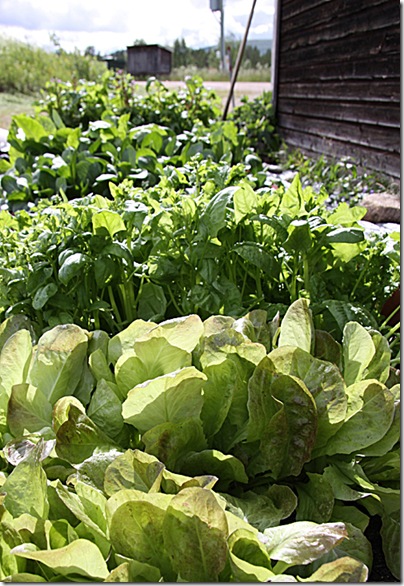 The season is shorter but the midnight sun makes up for the delay in spring. Everything grows at a higher speed and fast growing vegetables grow even faster. Last June I sowed different vegetable seeds in wooden frames and covered by geotextile to prevent the soil from drying up. When I returned about three weeks later, this had happened. If you want to speed thing up even more, you can paint the frames black.
The season is shorter but the midnight sun makes up for the delay in spring. Everything grows at a higher speed and fast growing vegetables grow even faster. Last June I sowed different vegetable seeds in wooden frames and covered by geotextile to prevent the soil from drying up. When I returned about three weeks later, this had happened. If you want to speed thing up even more, you can paint the frames black.
 A bee beetle (Trichius fasciatus) on a double Scotch rose Rosa pimpinellifolia ‘Plena’. There are lots of different old fashioned roses that are hardy in Lapland but also many new cultivars from Canada. The climate makes them smaller than further South. If you want a high and dense rose bush, you should plant one of the hardiest cultivars.
A bee beetle (Trichius fasciatus) on a double Scotch rose Rosa pimpinellifolia ‘Plena’. There are lots of different old fashioned roses that are hardy in Lapland but also many new cultivars from Canada. The climate makes them smaller than further South. If you want a high and dense rose bush, you should plant one of the hardiest cultivars.
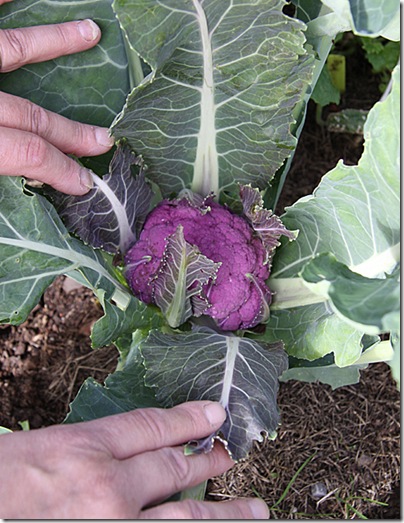 A purple cauliflower in Vuollerim just South of the Arctic circle. The many hours of sunlight and the lack of pests gives the vegetables a higher quality. Often berries from Northern Sweden, for example black currant, have a higher content of vitamin C.
A purple cauliflower in Vuollerim just South of the Arctic circle. The many hours of sunlight and the lack of pests gives the vegetables a higher quality. Often berries from Northern Sweden, for example black currant, have a higher content of vitamin C.
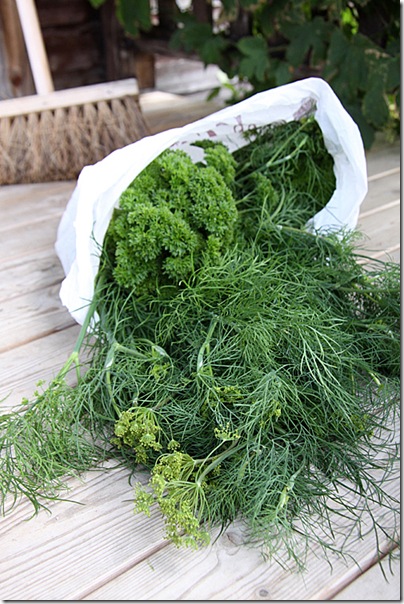 Vegetables not only look better but they also get crisper and have a richer flavor. This is my harvest of dill and parsley from last summer in the mountain area West of Jokkmokk. I keep it in the freezer during winter. Every time I sprinkle it over a dish, it’s like adding a piece of last summer. The dill flowers give a good flavor when you cook crayfish.
Vegetables not only look better but they also get crisper and have a richer flavor. This is my harvest of dill and parsley from last summer in the mountain area West of Jokkmokk. I keep it in the freezer during winter. Every time I sprinkle it over a dish, it’s like adding a piece of last summer. The dill flowers give a good flavor when you cook crayfish.
Most of Europe is densely populated with shrinking areas of wild nature but Lapland still has extensive areas of wild forests. While many gardens in England and Holland create woodlands and prairie like borders, the gardens in Lapland do the opposite. They’re more controlled to point out the contrast between the garden and the deep forest. The gardens are open with no fences or hedges. The well trimmed lawn clearly points out where the garden begins and nature starts. I believe it’s a way to control nature, to keep it at a distance, rather than bringing it in to the back yard.
